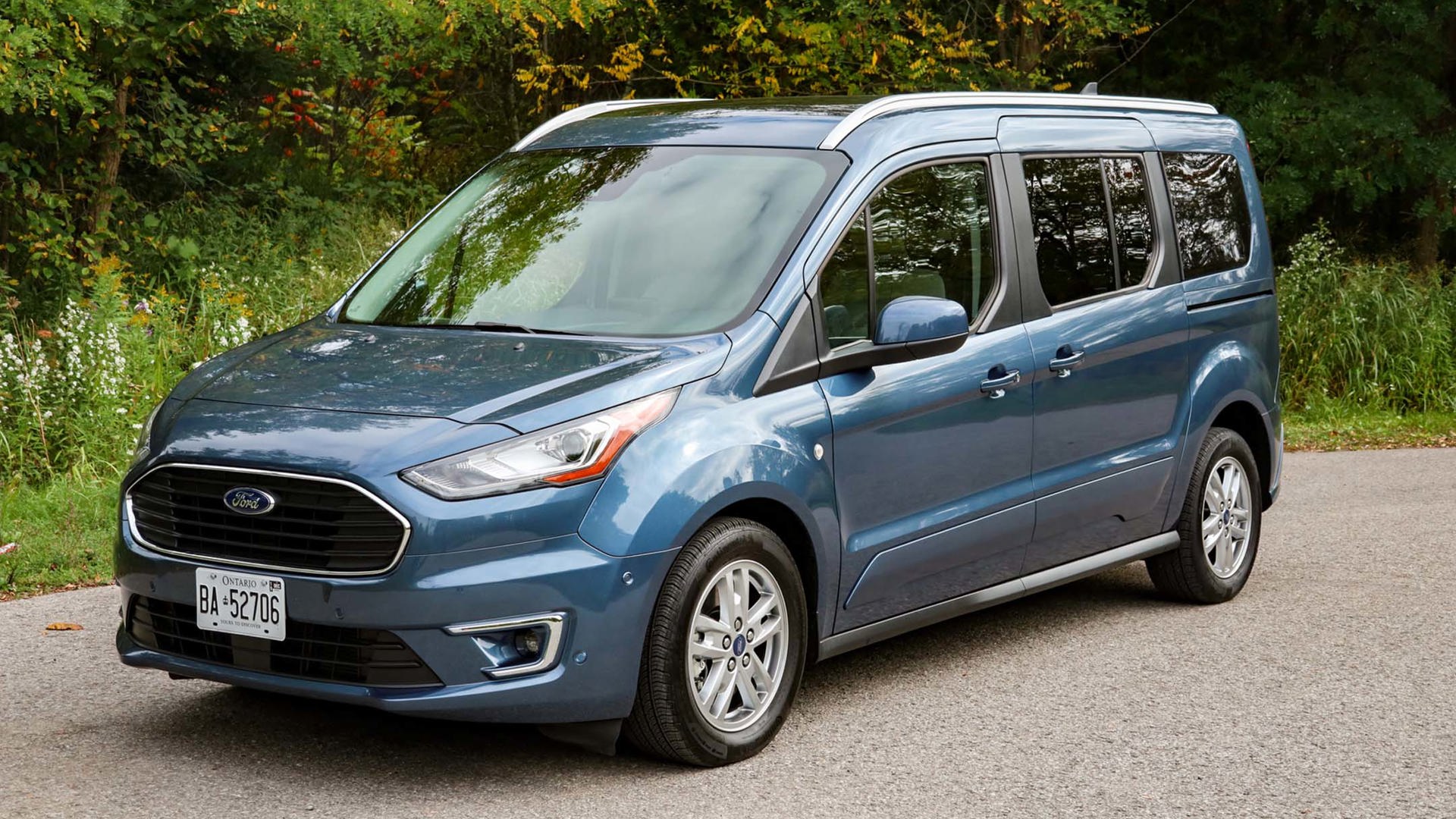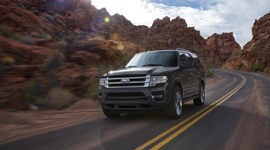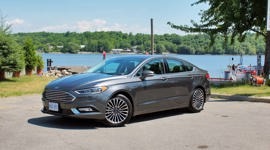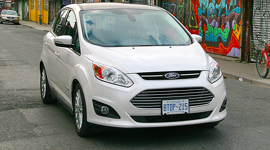 AutoTrader SCORE
AutoTrader SCORE
-
STYLING8/10
-
Safety9/10
-
PRACTICALITY6/10
-
USER-FRIENDLINESS8/10
-
FEATURES8/10
-
POWER7/10
-
COMFORT8/10
-
DRIVING FEEL8/10
-
FUEL ECONOMY8/10
-
VALUE6/10
Every now and then, automakers transform consumer vehicles to commercial ones. (In Europe, for example, it’s possible to buy a windowless “van” version of the Ford Fiesta subcompact hatchback.) Occasionally, commercial vehicles are converted for consumer use, as is the case of Ford Transit Connect with three rows of seats inside.
Although it’s primarily sold as a cargo van, the Transit Connect also comes as a passenger wagon. While it really isn’t a direct replacement for a minivan – more on that later – for some families it could be a viable candidate as a people-mover.
Styling: 8/10
The Transit Connect makes the most of its boxy styling, especially at the Titanium level, where it gets brightwork on its grille, and the wheels – 16-inch on all trim levels – are aluminum instead of the steel-with-plastic-covers on the other two trims. (And in a world where most minivans run on 18- or 19-inch wheels, expect to pay less for your winter or replacement tires, too.)
As with minivans, the Transit Connect has sliding doors on both sides. All trim levels come with a liftgate, but the XL and XLT can be optioned with side-hinged cargo doors at the rear.
The squared-off shape maximizes headroom very generously, and some might be able to almost stand up in the van while tending to their younger passengers.
Safety: 9/10
The Transit Connect gets the top rating of five stars overall from the U.S. National Highway Traffic Safety Administration (NHTSA), earning five stars for side crash protection, and four each for frontal and rollover protection. (That said, almost every vehicle rates no more than four stars for rollover.) The Insurance Institute for Highway Safety (IIHS) hasn’t rated it, which isn’t unusual for commercial vehicles.
All trim levels include front collision warning with emergency braking, curtain airbags across all three rows, tire pressure monitoring system, and MyKey, which lets you limit or monitor seatbelt use, radio volume, safety features, and maximum speed when handing over the keys to other drivers. Ford’s Co-Pilot360 is standard on the XLT and Titanium, and available on the XL; it includes blind-spot monitoring, rear cross-traffic alert, lane departure-warning, and automatic high-beams.
My vehicle was equipped with a “Quick-Clear” windshield for an additional $260, which quickly defrosts that large front surface. However, it uses tiny, tightly spaced vertical wires in the glass. Once you catch sight of them, you can’t unsee them and must look past them, which I find tiring on long drives.
Practicality: 6.5/10
The Transit Connect has the inherent practical nature of all people-movers, with six- or seven-passenger seating (two second-row chairs are standard but can be optioned to a three-seater bench), and with cargo space behind the third row. There’s also a full-width parcel shelf above the windshield.
So why didn’t it get a higher score? It’s because while all is good when you just stash people inside, things get much stickier when you want to change the configuration – which is why, as mentioned above, it isn’t necessarily a head-to-head rival to a minivan.
In a minivan, there’s a well in the floor behind the third row. This increases cargo capacity, and it’s usually a one-handed operation to drop those back-row seats into it to provide a flat floor. Because it’s based on a cargo van, the Transit Connect doesn’t have that well, and you must flip up the third-row’s seat cushions before you can fold down their seatbacks, which then lie on top of the floor rather than under it. The second-row chairs fold but not as low as the third-row seats, so you can’t load in large flat objects. And to get legroom in the third row you must slide those seats back, which chews up the storage space behind them.
User Friendliness: 8/10
The not-so-friendly seat-folding aside, the rest of the Transit Connect is simple and easy to operate. Dual-zone climate control is standard, with dials to adjust the temperature and buttons for the vent modes, and with separate rear climate controls. The fan speed would be easier with a single up-down toggle, though, rather than two separate buttons on either side of the indicator lights.
The stock 6.5-inch centre touchscreen is powered by SYNC 3 and it’s easy to use once you’ve tapped the “Control” icon to bring up the various functions. In addition to the touchscreen, you can also use voice control to activate many of the tasks. It worked well when I mentioned address destinations, and the navigation system nailed each one on the first try.
Features: 8/10
For a vehicle that’s primarily built for fleet use, the Transit Connect wagon comes with a decent list of items – although you may have to pay extra or move up a trim level to get some of them. The infotainment system includes Apple CarPlay, Android Auto, satellite radio, and two charging points on the XLT and Titanium (those are optional on the base XL, which just has an AM/FM radio with Bluetooth), while the Titanium adds navigation. Both the middle and top trims include a wireless phone charger. A rear-view camera is standard, but that’s a federal requirement on all new vehicles.
The XLT and Titanium include a power driver’s seat, heated power-folding mirrors, rain-sensing wipers, conversation mirror, and a carpeted floor – although the XLT can be optioned with the XL’s vinyl floor, always a bonus for easy cleaning. The Titanium further adds leather upholstery, heated front seats, auto-dimming rear-view mirror, and high-intensity-discharge (HID) headlights.
My tester had several options added to it, including a trailer hitch (the Transit Connect can tow up to 2,000 lb) and a self-parking feature, which worked well but, like virtually all of these, is slower than just putting it in the space yourself.
Power: 7/10
The Transit Connect uses a non-turbo, 2.0L four-cylinder engine that makes 162 hp and 144 lb-ft of torque, mated to an eight-speed automatic transmission. (Ford also offers it with a more powerful 2.5L engine, but only to commercial fleet buyers.) Although the Transit Connect is assembled in Spain, the 2.0L engine is made in Michigan.
It’s a relatively new setup for the Transit Connect: the 2.0L became the default engine in the 2019 model. Prior to that, it carried the 2.5L, and for a while, you could get a turbocharged 1.6L four-cylinder. Ford even promised a light-duty diesel for last year’s model, but it never materialized.
The engine runs on regular-grade gasoline but is also equipped for E85 ethanol blend, a renewable fuel that’s also virtually impossible to find in most areas. The engine’s power goes strictly to the front wheels, and all-wheel drive is not available.
Comfort: 8/10
The Transit Connect’s seats are supportive and comfortable; I’ve taken one of these vans on a full day’s drive and they only started to get a bit hard around the six-hour mark. The six-way power driver’s seat helps with finding the right spot, but the front passenger only gets manual adjustment.
While not quite as contoured, the second-row chairs are also nice on the spine. In most vehicles, the third-row seats are usually hard and flat, but the Transit Connect’s back row also offers a decent level of comfort – although, as mentioned previously, you have to sacrifice much of your cargo space to put legroom back there.
Driving Feel: 8/10
A little more power wouldn’t be a bad thing, especially when the van’s loaded up and acceleration can be leisurely off the line. But it’s fine once it gets going, and the eight-speed automatic shifts smoothly.
It drives very well, and feels more like a minivan than a work truck. Its tight turning circle lets you spin it easily around crowded parking lots, and the steering is well-weighted and responsive. It feels well-planted on the highway, and despite its height, takes corners smoothly without a minimum of any tippy feeling to it. In addition to blind-spot monitoring, the Transit Connect has “spotter” mirrors, with convex inserts that make it easier to see what’s alongside when parking.
Fuel Economy: 8/10
The Transit Connect is officially rated at 9.9 L/100 in the city and 8.2 on the highway, with a combined rating of 9.2 L/100 km. That’s the lowest consumption figure among minivans, but keep in mind that all of those have V6 engines and make more power. In my week with it, I came in almost right on the mark at 9.3 L/100 km. And filling up is simple, because it uses Ford’s Easy Fuel capless filler.
Value: 6/10
We said the Transit Connect isn’t a head-to-head replacement for a minivan, but we also realize that any consumers considering it will use it as one, and that’s why we’ve rated it relatively low on the value scale. It starts at $32,055 for the base trim, barely more than the Kia Sedona’s base MSRP of $31,995, or a Dodge Grand Caravan that can drop below $30,000 when sweetened with factory incentives.
The Toyota Sienna and Honda Odyssey start at $35,545 and $36,290, respectively, and both go over $52,000 at their top-line levels – but the highest-level Transit Connect Titanium starts at $38,025, and you can get some solidly equipped minivan trim levels around the $40,000 mark. And the minivan choice will overcome some of the Transit Connect’s shortcomings, including more rear cargo space, much-easier-to-fold rear seats, and on some vans, eight-passenger seating to Ford’s maximum of seven.
The Verdict
So why not opt for a minivan? The fact is that most consumers will, and that’s why Ford doesn’t advertise its trucklet as a direct competitor to a family van. But for some, especially those looking for utility above all, the four-cylinder fuel economy, generous headroom, available super-easy-to-clean vinyl floor, and simple controls could be enough to make it a viable contender.
| Engine Displacement | 2.0L |
|---|---|
| Engine Cylinders | I4 |
| Peak Horsepower | 162 hp @ 6,500 rpm |
| Peak Torque | 144 lb-ft @ 4,500 rpm |
| Fuel Economy | 9.9/8.2/9.2 L/100 km cty/hwy/cmb |
| Cargo Space | 461–705 / 1,702 / 3,002 L behind 3rd/2nd/1st row |
| Model Tested | 2020 Ford Transit Connect Titanium Wagon |
| Base Price | $38,025 |
| A/C Tax | $100 |
| Destination Fee | $1,900 |
| Price as Tested | $44,844 |
|
Optional Equipment
$4,819 – Engine block heater, $100; panoramic sunroof, $1,750; Quickclear windshield defroster, $260; adaptive cruise control, $784; enhanced active park assist, $1,000; trailer tow hitch, $425; remote start, $350; flex fuel capability, $150
|
|













































